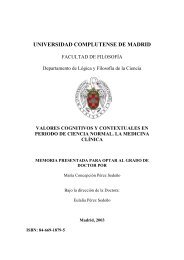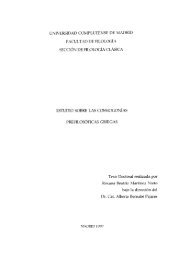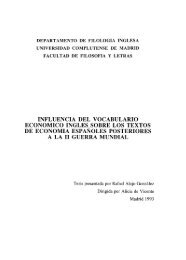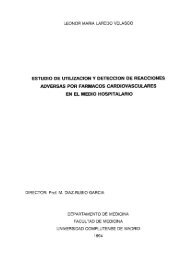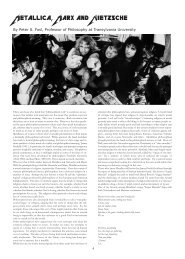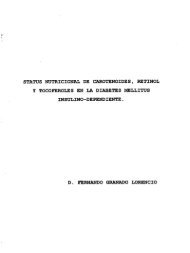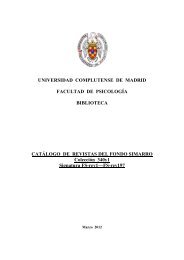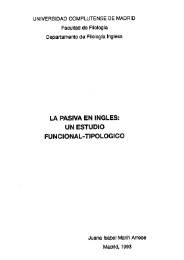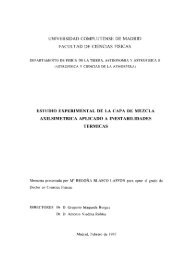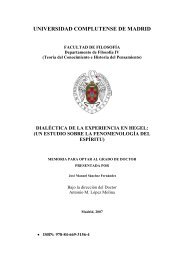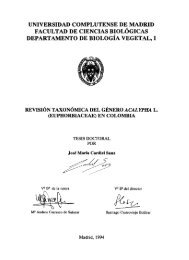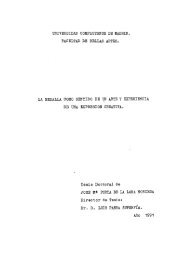ABRIR 3.2. La adolescencia - Biblioteca de la Universidad ...
ABRIR 3.2. La adolescencia - Biblioteca de la Universidad ...
ABRIR 3.2. La adolescencia - Biblioteca de la Universidad ...
You also want an ePaper? Increase the reach of your titles
YUMPU automatically turns print PDFs into web optimized ePapers that Google loves.
Ficción y Realidad en <strong>la</strong> obra <strong>de</strong> Truenan Capole<br />
comentado en profundidad: <strong>la</strong> muerte <strong>de</strong> <strong>la</strong>s tías. En 1934, Uncle Bud<br />
falleció. Tres años más tar<strong>de</strong>, 1937, fue Callie quién murió y finalmente<br />
Sook, en 1946. Jennie no murió hasta 1958. <strong>La</strong> muerte <strong>de</strong> Sook tan<br />
cercana pue<strong>de</strong> ser que haga al autor imaginar que todas sus tías murieron<br />
puesto que su re<strong>la</strong>ción con Jennie nunca fue buena. Por ello, este dato<br />
pue<strong>de</strong> ser una forma simbólica para dar a enten<strong>de</strong>r que sus familia estaba<br />
muerta: unos fisicamente, otros afectivamente.<br />
Por otro <strong>la</strong>do, en 1948, Truman Capote viaja a Haiti y el resultado<br />
este artículo, el cual está re<strong>la</strong>cionado con “Music Por Chamaleons”. En<br />
ese viaje Truman Capote entra en contacto con un mundo diametralmente<br />
opuesto al suyo don<strong>de</strong> <strong>la</strong>s altas esferas intelectuales y sociales <strong>de</strong>l lugar<br />
difieren por completo <strong>de</strong> <strong>la</strong>s esferas americanas. Llega Truman a un mundo<br />
<strong>de</strong> ~istemas <strong>de</strong> valores distintos. Allí entra en contacto con Hyppolite, un<br />
pintor al que Truman consi<strong>de</strong>ra interesante ya que “for there is notiting in<br />
his art that itas been slyly trasposed, he is using what lives within himselt<br />
and that is his country spiritual itistor>’, its singings and worships.” (Capote<br />
1950: 42)<br />
Aparte <strong>de</strong>l pintor, Capote introduce a otros personajes igual <strong>de</strong><br />
curiosos que aquel y que le hacen al autor preguntarse por <strong>la</strong> cultura, el<br />
turismo y <strong>la</strong>s tradiciones <strong>de</strong>l país. Así se pregunta por <strong>la</strong> fauna e<br />
irónicamente se pregunta por <strong>la</strong> razón <strong>de</strong> un número tan elevado <strong>de</strong> perros.<br />
Se pregunta igualmente por <strong>la</strong> escasa afluencia <strong>de</strong> turismo y, a <strong>la</strong> vez, asiste<br />
expectante a una carnaval y a su ritual. Este viaje que parece le resultó tan<br />
interesante, resulta ser, en pa<strong>la</strong>bras <strong>de</strong>l autor a John Malcolm Brinnin, un<br />
viaje un tanto inseguro y <strong>de</strong>sagradable<br />
“As 1 was saying, 1 learned something. . .1 think 1<br />
un<strong>de</strong>rstood for the first time in my life titat 1 wasn’t nearí>’<br />
as interested in saving my skin as in saving what 1 know,<br />
Página 470



